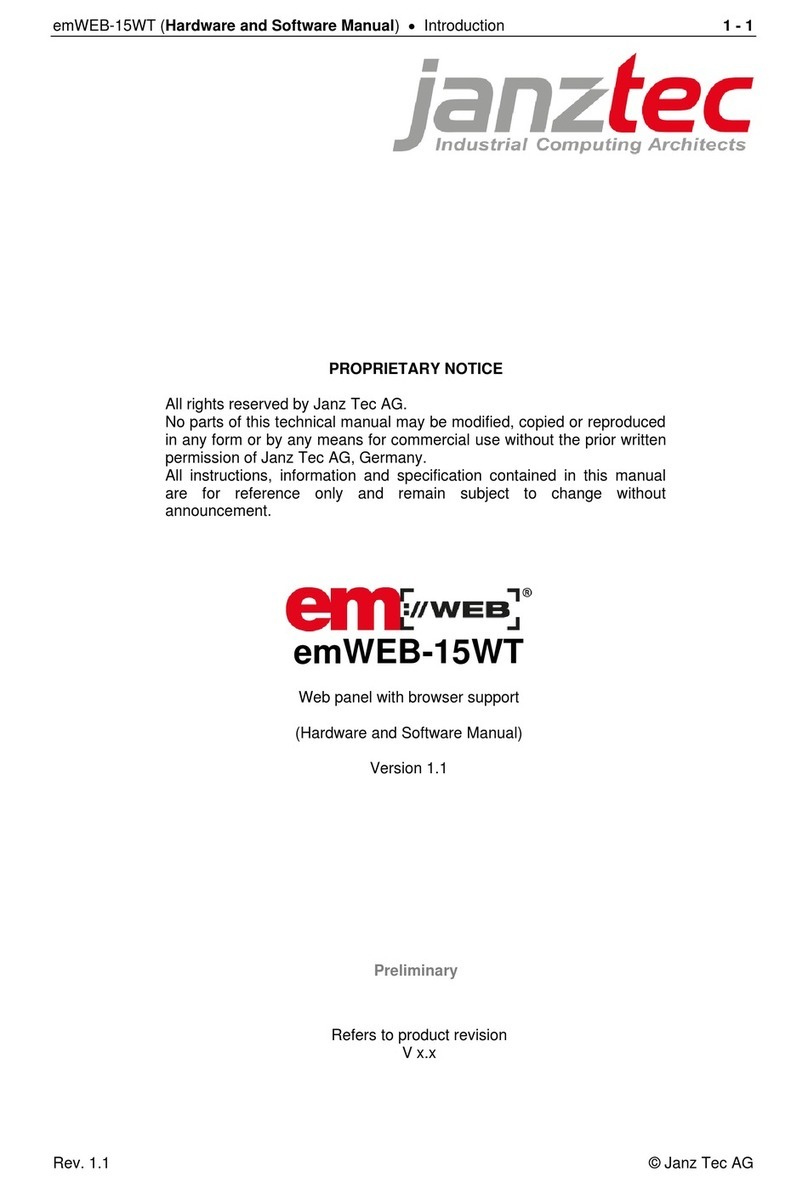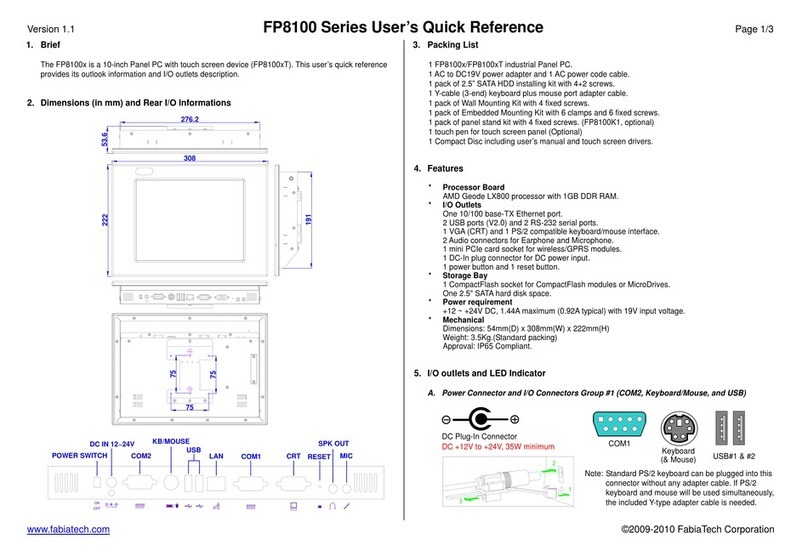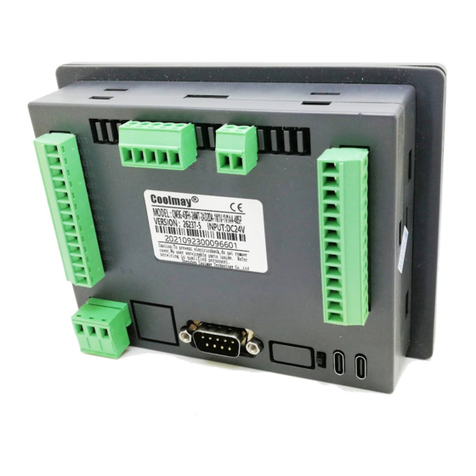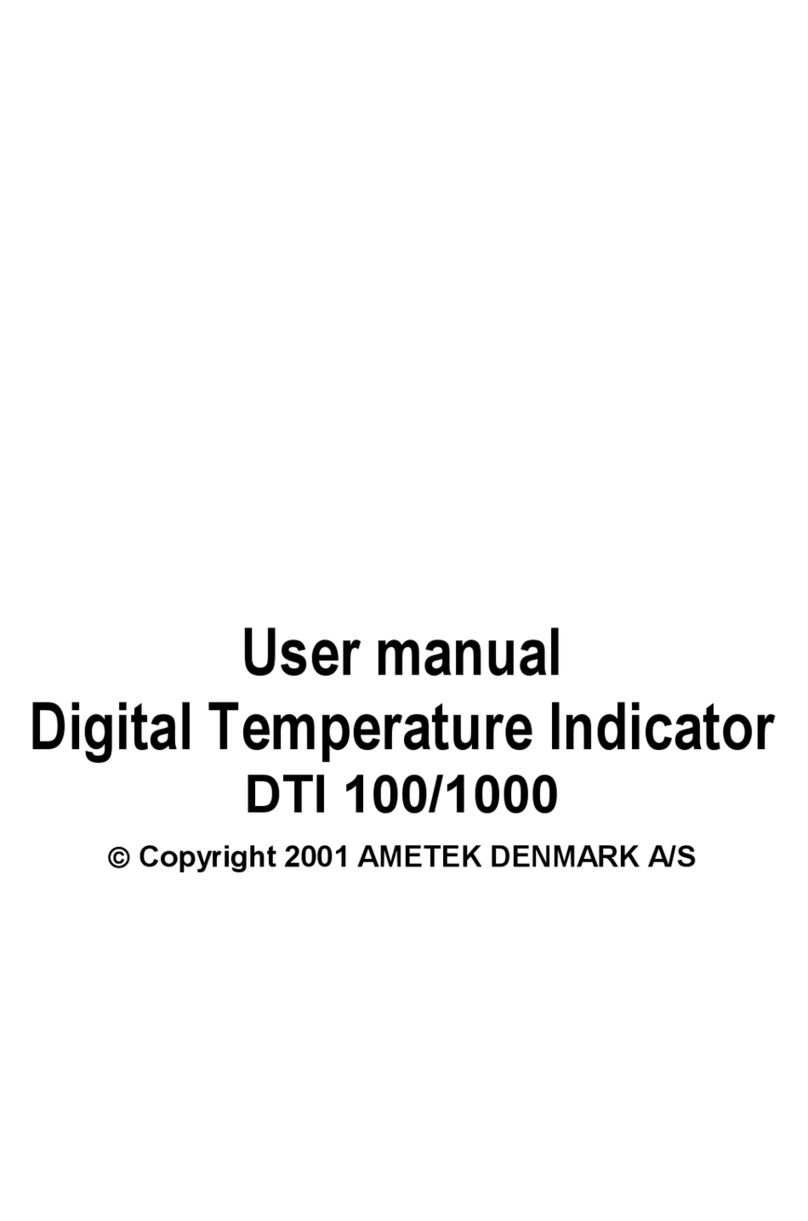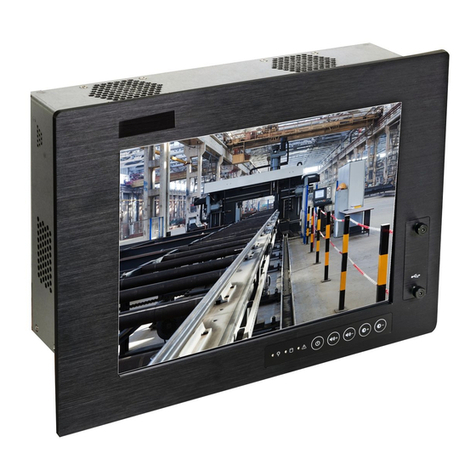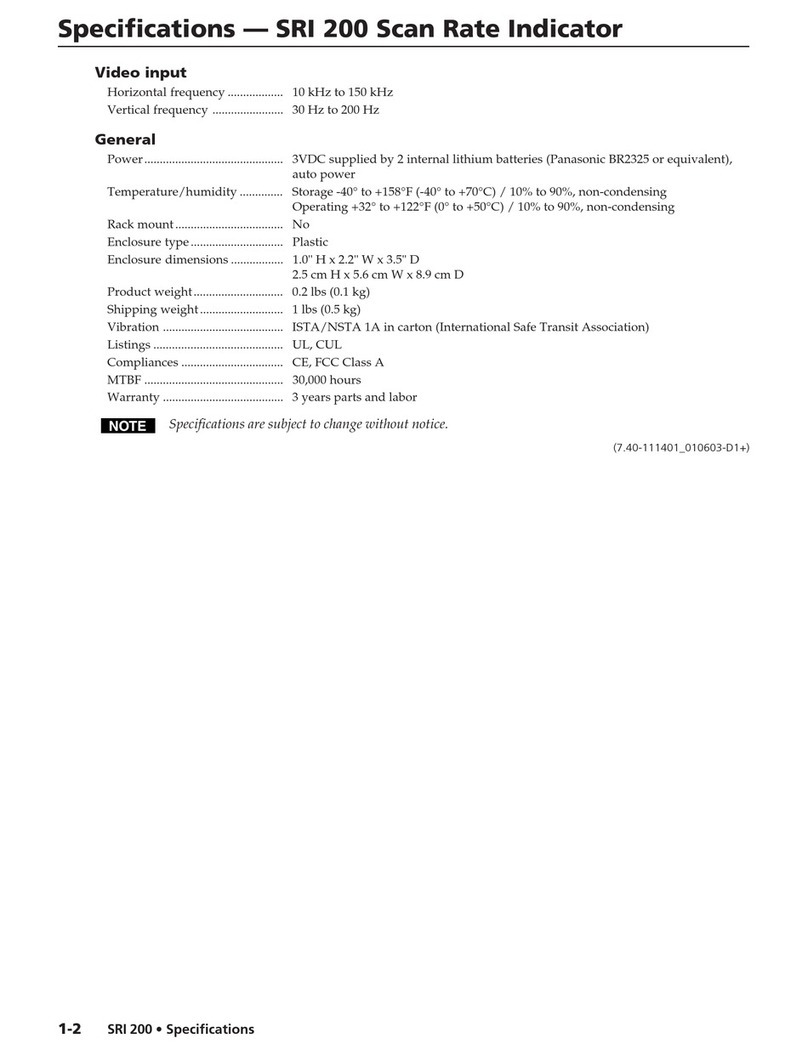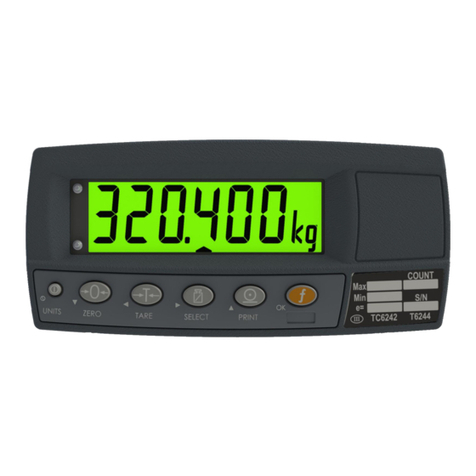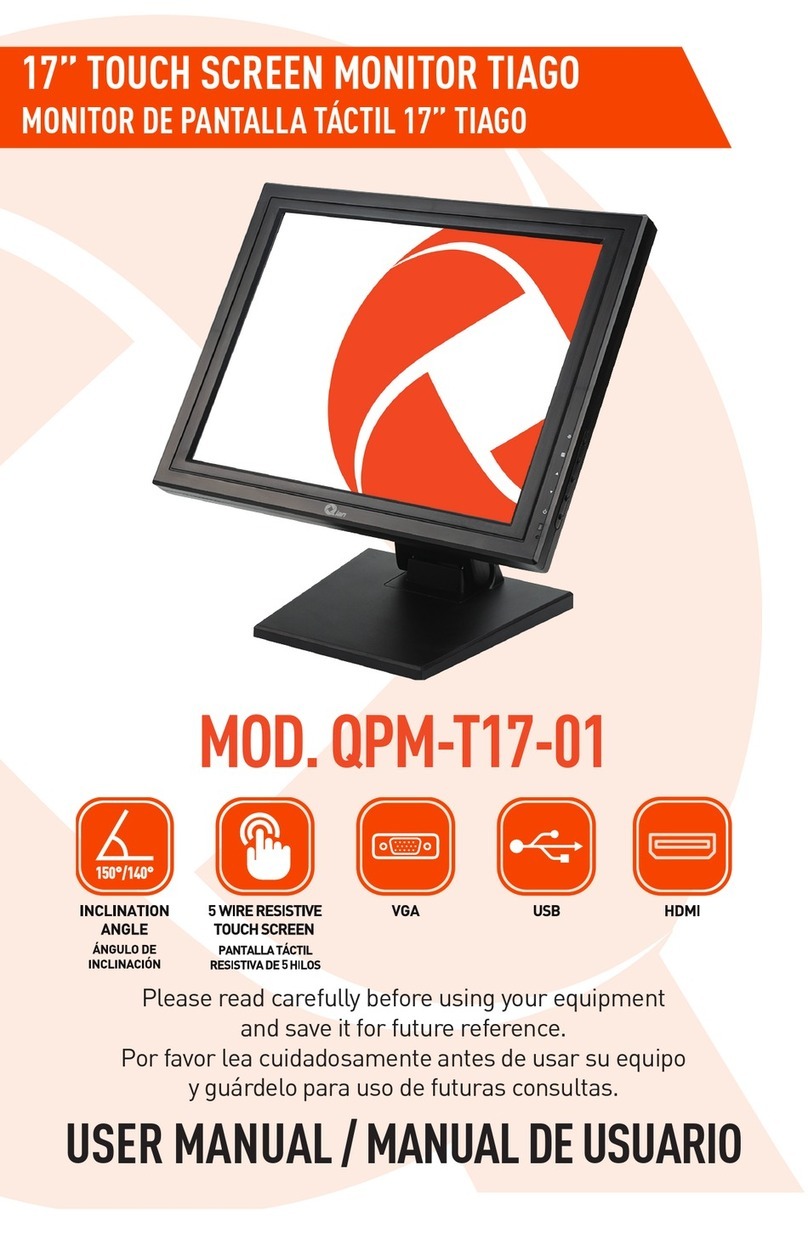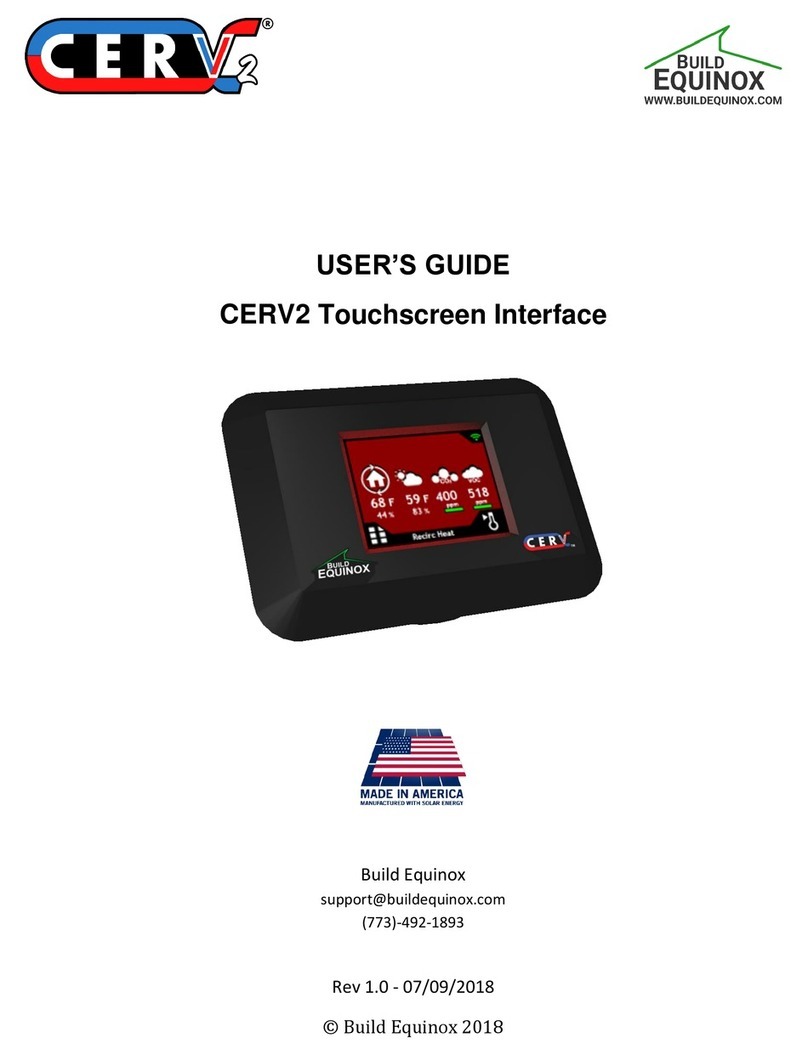GREER Company MicroGuard User manual

GREER COMPANY Page 1 of 22
Crane Systems
GREER COMPANY 1918 E. Glenwood Place, Santa Ana, CA 92705 Telephone: (714) 259-9702 Fax: (714) 259-7626
MicroGuard® 586 Retrofit Calibration Manual PN W458199 Rev A 09/27/02
MicroGuard®586 Retrofit
Rated Capacity Indicator System
Calibration and Testing for:
Machine Model
Serial Number
Tester
Date

GREER COMPANY Page 2 of 22
Crane Systems
GREER COMPANY 1918 E. Glenwood Place, Santa Ana, CA 92705 Telephone: (714) 259-9702 Fax: (714) 259-7626
MicroGuard® 586 Retrofit Calibration Manual PN W458199 Rev A 09/27/02
MicroGuard®586 Retrofit
Rated Capacity Indicator System
Table of Contents
Introduction ..................................................................................................................... 3
MicroGuard®586 Key Definitions .................................................................................... 3
Preliminary Checks ......................................................................................................... 4
Boom Hoist Geometry ..................................................................................................... 4
Miscellaneous Data......................................................................................................... 5
Installation Checks..................................................................................................................................6
Calibration Routines and Menu Entry.............................................................................. 6
00 Information ................................................................................................................. 6
01 Reset Data ................................................................................................................. 7
02 Dimensions ................................................................................................................ 7
03 Zero Angle Sensor ..................................................................................................... 8
04 Zero Extension Sensor............................................................................................... 8
05 Pressure.....................................................................................................................8
06 Radius/Moment ....................................................................................................... 8-9
07 Deflection .............................................................................................................. 9-10
08 Calibrate Fly ............................................................................................................. 10
09 Stowed Jibs.............................................................................................................. 11
10 Digital Input .............................................................................................................. 11
11 Angle Rate ............................................................................................................... 11
Worksheets .............................................................................................................. 12-21

GREER COMPANY Page 3 of 22
Crane Systems
GREER COMPANY 1918 E. Glenwood Place, Santa Ana, CA 92705 Telephone: (714) 259-9702 Fax: (714) 259-7626
MicroGuard® 586 Retrofit Calibration Manual PN W458199 Rev A 09/27/02
Introduction
Congratulations on purchasing the new MicroGuard®586 Retrofit System.
This document describes the calibration process for the MicroGuard®586 System in an onsite situation,
assuming that there is no prior knowledge of the geometry of the crane.
This document is designed to assist the calibration personnel in keeping a record of measured
dimensions and test results for review and comparison when subsequent modifications are made to the
capacity chip. This data will provide an on-file record, which may serve future upgrades and changes to
MicroGuard®designs.
Recording this important data during the calibration process will ensure a structured and easy to follow
calibration that in turn leads to an accurate and safe calibration.
Notice
This document and resulting data about the crane are confidential.
Copies of this document may not be distributed to third parties in any
form without the prior written consent of the Greer Company and the
crane manufacturer.
Tools Required
Digital Volt/Ohmmeter
Inclinometer – accurate to 0.1°
Measuring tape
Hand tools
The above keys will be referred to many times in the following procedures. The “UP” and “DOWN” arrow
keys are used to select from menus and to increase or decrease numeric values on the display.
The “SETUP/OK” key is usually used to enter a finished number or enter a function via a menu.
The “ALARM CANCEL” key is often used to exit a routine.

GREER COMPANY Page 4 of 22
Crane Systems
GREER COMPANY 1918 E. Glenwood Place, Santa Ana, CA 92705 Telephone: (714) 259-9702 Fax: (714) 259-7626
MicroGuard® 586 Retrofit Calibration Manual PN W458199 Rev A 09/27/02
Preliminary Checks
Before starting calibration, it is important to check the machine geometry. Geometric values may have
been previously entered into the capacity chip from the crane application data sheet filled out by the
crane manufacturer’s engineering department. This data will appear in the relevant boxes, but should
STILL be checked by the calibration personnel.
The following pages provide a list of required measurement checks. Measured values should be entered
in the spaces provided.
Using an accurate tape, measure each dimension shown. It is, at best, a difficult exercise to measure
these dimensions, but still a necessary check. It is recommended that two people carry out this task.
Ensure that clear reference points are used when making measurements.
Boom Hoist Geometry
Dimension “L” is the distance parallel to the boom centerline between the center of the Boom pivot and
the center of the upper Boom Hoist cylinder pivot.
Dimension “J” is the distance at 90 ° to the boom centerline between the center of the Boom pivot and
the center of the upper Boom Hoist cylinder pivot. J is negative when the Boom pivot is above the upper
Boom Hoist cylinder pivot and positive when it is below.
Dimension “G” is the horizontal distance between the center of the Boom pivot and the center of the
lower Boom Hoist cylinder pivot.
Dimension “H” is the vertical distance between the center of the Boom pivot and the center of the lower
Boom Hoist pivot.
It is recommended that the boom is level when measuring dimensions “L” and “J.”
The carrier is assumed to be level for the purposes of measuring dimensions “G” and “H.”
Enter the measured values into each of the gray boxes provided below.
*If the Boom pivot is above the Boom Hoist cylinder Upper pivot (as shown), dimension “J” is negative.
Clearly indicate “+”or “-”.The above illustration shows dimension “J” as negative.
H
J
GBoom Hoist Cylinder
Boom
Boom Pivot
Lower Pivot
Upper Pivot
L
*

GREER COMPANY Page 5 of 22
Crane Systems
GREER COMPANY 1918 E. Glenwood Place, Santa Ana, CA 92705 Telephone: (714) 259-9702 Fax: (714) 259-7626
MicroGuard® 586 Retrofit Calibration Manual PN W458199 Rev A 09/27/02
Miscellaneous Data
The following checks are for Main Boom Head Sheave Radius and Swing Offset. Swing Offset
is negative when the boom pivot is behind the center of rotation. Measure the circumference of the
boom hoist cylinder rod, which can be done by wrapping a tape around the rod and reading off the value.
Enter the measured values in the gray boxes provided.
Measure the W Dimensions on Non Boom-Mounted Hoist Reels.
Measure “W” at a low angle <20 ° and at a high angle >60 °. ‘W’ is the shortest
distance from the boom pivot to the hoist rope.
Boom Hoist Cylinder
Boom
Boom Pivot
Swin
g
Offset
Hd Shv radius
Top Sheave
Head Sheave
Center of Rotation

GREER COMPANY Page 6 of 22
Crane Systems
GREER COMPANY 1918 E. Glenwood Place, Santa Ana, CA 92705 Telephone: (714) 259-9702 Fax: (714) 259-7626
MicroGuard® 586 Retrofit Calibration Manual PN W458199 Rev A 09/27/02
Installation Checks
• Check wiring and EPROM installations.
• If swing switches are fitted, perform the digital input monitor routine via the MicroGuard®display
to ensure that the switches operate correctly.
• Set the Extension Reel Clutch.
Calibration Routines and Menu Entry
The calibration routines, which are hidden from normal use, require the use of the entry code supplied
with this manual.
To Enter the Calibration Mode: Hold down the ALARM CANCEL key and the UP ARROW key for
about 6 seconds. A message requesting a PIN entry should appear. Use the UP and DOWN keys to
enter the PIN, which is 112; calibration entry is complete. If incorrectly entered, the display will return to
the normal working mode.
Once in the calibration mode, the options below are available. Use the UP or DOWN arrow key to display
the desired option. Then, use the SETUP/OK key to enter the routine.
To exit the calibration menu at any time, press the ALARM CANCEL key; this action will return the system
to the normal working screen. After the initial entry of the PIN, the calibration mode can be re-entered at
any time by holding down the ALARM CANCEL and UP arrow keys. No code entry will be required as
long as the power is not reset.
00 - Information - Displays system information and error codes.
01 - Reset Data - Crane data reset to initialize system before calibrating.
02 - Dimensions - Allows entry of crane geometry.
03 - Angle Sensor - Allows calibration of the angle sensor.
04 - Extension Sensor Allows calibration of the extension sensor.
05 - Pressure - Allows calibration of boom hoist dimensions.
06 - Radius/Moment- Allows calibration of radius and boom moment parameters.
07 - Deflection - Allows entry of a boom bending correction.
08 - Calibrate Fly - Allows calibration of fly/jib dimensions.
09 - Stowed Jibs - Allows entry of stowed jib data.
10 - Digital Input - Allows viewing of digital input status.
11 - Angle Rate - Calibrates dynamic properties of the boom.
12 - Data Viewer - Allows viewing of system variables.
00 Information
This routine allows viewing of the system error codes and the crane specific applications file used
in the computer. Use the UP or DOWN arrow keys to move between information displays.
The following information is available:
1. System Error Codes (See Appendix for description).
2. Computer specific serial number (should match the number on the computer box).
3. The crane specific applications file used for system RESET.
4. Suggested diagnostics. These are recommendations on how to finish or improve a calibration.
All calibration functions are not pertinent to all cranes; therefore, some diagnostic suggestions
may not apply.
5. Exit the routine using the ALARM CANCEL key.

GREER COMPANY Page 7 of 22
Crane Systems
GREER COMPANY 1918 E. Glenwood Place, Santa Ana, CA 92705 Telephone: (714) 259-9702 Fax: (714) 259-7626
MicroGuard® 586 Retrofit Calibration Manual PN W458199 Rev A 09/27/02
01 Reset Data
“Reset Data” from the calibration menu will display the status of the “Personality.” If the system has been
reset and is functioning correctly, it should say, “Personality is good.”
In order for calibration to begin again, the crane RESET DATA MUST be implemented. This function will
erase the Personality memory, which stores crane specific data and dimensions; it will also copy any
known data from the on-board ROM applications file to the working personality memory for use by the
system.
To reset crane data, simply enter the routine using the SETUP/OK key, then confirm the reset command
be pressing the indicated keys.
02 Dimensions
The dimensions routine will show the current values of the following crane dimensions.
Use the UP or DOWN keys to modify the displayed values. Use the SETUP/OK key to move on and save.
Use the ALARM CANCEL key to exit this routine.
Procedure:
1. Enter Swing Offset - Enter value from above worksheet.
2. Enter Ram L - Enter value from above worksheet.
3. Enter Ram J - Enter value from above worksheet.
4. Enter Ram G - Enter value from above worksheet.
5. Enter Ram H - Enter value from above worksheet.
6. The system will now ask, “Is the winch mounted on the boom?” Press the button under the
Y/N caption to make a selection.
• If “YES,” the system will require no more information regarding the crane winch.
• If “NO,” the system will ask, “Calibrate Hoist Rope Dimensions?” Unless previously
calibrated, press “YES” and work through the following calibration procedure. If previously
calibrated, press “No” to continue.
Calibrating the Hoist Rope
a. Follow the instructions provided on the screen, instructing the operator to move the boom to a
high and low angle while fully telescoped in.
b. Measure the shortest distance from the boom pivot to the hoist rope. This can be done by
placing one end of the tape on the pivot and arcing the tape to find the shortest distance.
c. The dimensions entered are “High Angle W” and “Low Angle W.” (See above worksheet on
measuring W dimensions on non boom-mounted hoist reels.)
Continue with steps 7-13 below.
7. Head Shv. Rad - Enter value from above worksheet.
8. Enter RopeLim - Maximum line pull for a single part of line.
9. Enter Max POL - Maximum parts of line allowed on the main boom.
10. Enter Max Ext - Maximum boom extension allowed.
11. Load Scale - A load multiplier, usually set to 1.0.
12. Length Offset - Display offset added to length (gets over some OEM cheats).
13. Retracted Length - Retracted length of boom. (Measure it!)

GREER COMPANY Page 8 of 22
Crane Systems
GREER COMPANY 1918 E. Glenwood Place, Santa Ana, CA 92705 Telephone: (714) 259-9702 Fax: (714) 259-7626
MicroGuard® 586 Retrofit Calibration Manual PN W458199 Rev A 09/27/02
03 Zero Angle Sensor
Mechanically zero the Boom Angle Sensor. Instructions for setting the potentiometer are contained
in the Extension Reel installation manual. Double-check that the boom has been set level prior to setting.
Set the angle sensor pot voltage to 1/10th of the drive voltage at the extension reel (0.5 V nominal).
Once the zero is mechanically set, a more accurate zero can be obtained electronically by positioning the
boom as near to 0 ° (zero) as possible and pressing the DOWN arrow key to zero the display.
04 Zero Extension Sensor
Mechanically zero the Boom Extension Sensor. Instructions for setting the potentiometer are contained in
the Extension Reel installation manual.
Double-check that the boom is fully retracted prior to setting.
Set the Extension Reel zero by measuring the drive voltage and adjusting the pot until the extension
voltage is equal to 1/20th of the drive voltage (0.25 V nominal).
Once the zero is mechanically set, the zero can be set electronically more accurately by fully retracting
the boom and pressing the DOWN arrow key to zero the display.
05 Pressure
This routine uses a calibration load to compute the diameter of the hoist cylinder, if the diameter is
already known or is easily measured, simply skip the calibration option and enter the value directly at the
end of this routine.
THIS DIMENSION IS CRITICAL AND SHOULD BE MEASURED TO WITHIN 1/10th INCH.
Procedure:
1. Examine the piston and rod-side pressures when first entering the routine; these should read
positive numbers from around 20 to 3000 PSI with the boom not in its rest cradle. Press any key
to continue.
2. Enter the rod circumference from the above worksheet.
3. Enter the calibration load that will be lifted, including all shackles and hook weights. The load
should be as large a mass as is safe for the crane to pick with the boom as far retracted as
possible and at a boom angle of around 60 °. If only small test loads are available, use a longer
boom length.
4. Pick up the calibration load and hold it steady to settle any pressure fluctuations. Press “ok” to
continue.
5. Measure and enter the radius of the load suspended.
6. Set down the calibration load, allow it to settle, and then confirm the weight. The routine will exit
automatically upon completion.
7. Press the cancel key to Exit the Calibration Mode. Pick up the weight again. Check that the
displayed load rises by the correct amount.
8. Reenter the Calibration Mode and adjust, as appropriate.
06 Radius/Moment
This routine calibrates the natural moment and radius of the boom, taking into account its deflection
under its own weight.
Ensure that the boom configuration is set correctly, with the correct stowed attachment selected and
without erected attachments. If calibrating with a stowed attachment, check that the relevant stowed data
is entered into the system via the 10-Stowed Jibs routine BEFORE calibrating the main boom.

GREER COMPANY Page 9 of 22
Crane Systems
GREER COMPANY 1918 E. Glenwood Place, Santa Ana, CA 92705 Telephone: (714) 259-9702 Fax: (714) 259-7626
MicroGuard® 586 Retrofit Calibration Manual PN W458199 Rev A 09/27/02
Up to seven points may be stored; these points must include fully retracted and fully extended booms.
Intermediate points should be chosen where individual sections of the boom start to telescope and/or
where other sections stop telescoping, as the boom is extended.
For booms exhibiting an appreciable amount of flexibility or droop, it may be necessary to include an
extra point to improve accuracy, especially if there is a long distance between obvious points of
calibration. This is usually pertinent for long proportional booms, which may require only a fully retracted
and fully extended calibration.
Some booms exhibit a sudden droop when nearing the fully telescoped position. This droop is often due
to the design and fitting of wear pads inside the boom, which allow sections to hang on each other when
nearing the fully telescoped limit. Though this has little affect on main boom radius accuracy, the radius of
fly’s/jib may be affected by this characteristic. It is essential here to add an extra calibration point at about
90% of the boom extension.
For each extension calibration, the system requires a stable measurement of the moment (via its own
pressure sensors) and radius (via the calibration operator’s measurements) at a high angle only. Try to
pick angles of 60 ° – 70 ° for high angles. For low angles use 30 – 40 °.
Take care to accurately measure the radius at each calibration point. Using a single part-of-line
will be helpful.
When entering the Tare load in the calibration routine, it is usually a good idea to add a little to the hook
weight. Adding 100 pounds (or 50 Kilos) will help guarantee a slightly positive load reading in all operating
configurations.
Procedure:
1. Determine whether this will be a new calibration or an existing calibration with new or added points.
Be aware that a new calibration will destroy all radius moment data previously calibrated.
2. Enter the tare-load, which is the weight of extras added to the boom, i.e. the hook block, rope and
shackles.
3. Follow the instructions on the screen. For each length/calibration point:
i) Telescope to the desired length.
ii) Boom to a high or low angle.
iii) Measure and enter the radius. Allow the boom bounce to settle, and then move on.
iv) Boom to the other required angle; measure and enter the radius.
The routine can be exited at any time by pressing the “cancel” key.
Always check the computer to ensure that the angle is identified as a ‘high” or “low” angle. If the
display has indicated a different setting, use the up “high” or down “low” arrow keys to correct this.
To restart a calibration length, press “cancel” once.
Calibrated lengths are stored in Personality memory. To re-enter a single length, simply re-enter the
radius/moment routine. Select “No” for a single length. Select “yes” for a brand new calibration. Then
telescope to the required length and calibrate.
The boom parameters computed during a radius/moment calibration can be manually entered or adjusted
using the “EDIT” function available with the SETUP/OK key when first entering the routine.
07 Deflection
This routine is used to quantify the amount that a boom or attachment bends when under load. The boom
has its own bending factor called “F.” Each jib combination can have its own independent “F” value.
Before entering the routine, the display will show the angle of the boom head under no load and under the
current load.

GREER COMPANY Page 10 of 22
Crane Systems
GREER COMPANY 1918 E. Glenwood Place, Santa Ana, CA 92705 Telephone: (714) 259-9702 Fax: (714) 259-7626
MicroGuard® 586 Retrofit Calibration Manual PN W458199 Rev A 09/27/02
Procedure:
Make sure that the crane is configured to pick off the main boom, that all stowed attachments are set
correctly, and that there are no erected and unused attachments.
1. Fully extend the boom at a high angle of greater than 60 ° and lift a suitable calibration load.
The load should induce significant deflection in the boom.
2. Begin the calibration by pressing the SETUP/OK key.
3. Measure the loaded main boom radius and enter the value. It is a good idea to add 0.1ft or 0.1m
to the radius when entering the radius in the calibration for boom deflection. This will help ensure
a slightly positive radius in most operating conditions.
4. Check that the new displayed radius matches (or slightly exceeds) the actual measured radius.
5. Use the DOWN arrow key to edit the “F” number manually without entering a radius; this is useful
to trim the BDC up or down a bit.
Use this procedure for each fly/jib combination. Simply select the combination for calibration, re-enter
the routine, and repeat the procedure.
Completing the Main Boom
Ensure that the main boom calibrations on the previous pages have been completed and boom functions
thoroughly tested before calibrating the attachments identified in sections 08-11. These actions are
essential for the collection of good calibration data. Use the worksheet at the end of this book to record
test results for lifts.
08 Calibrate Fly
Perform a calibration on each jib configuration. Upon entry to the routine, the “edit” option can be used, if
desired, to manually enter pre-calibrated data. This option assists in making it possible to trim an existing
calibration that is less than perfect.
For each fly/jib combination, the system must gather data about the jib moment (through the pressure
sensors) and the jib radius contribution (through the engineer’s radius measurements). Data must be
gathered at high and low angles and for a retracted and extended main boom for EACH configuration.
Procedure:
1. Make sure that the crane is configured to be picking off the jib to be calibrated.
2. Enter the routine; bypass the edit option by selecting “N” for no with the DOWN arrow key.
3. Enter the main hook weight, if there is an unused hook picking off the main boom;
otherwise enter 0.0.
4. Enter the weight of the fly hook and any other shackles and rope weights suspended from the fly
pick point.
5. Follow the instructions on the screen. Move to retracted boom high and low angles to extended
boom, high and low angles. Let the boom bounce settle for several seconds. Then, measure and
enter the radius. After the four points are finished, the system will store the calibrated values and
exit.
6. Check the validity of the calibration with a ‘Test Load’ before moving to the next jib combination.
Completion
Upon completion of a jib calibration, record the test results in the worksheet at the end of this book.

GREER COMPANY Page 11 of 22
Crane Systems
GREER COMPANY 1918 E. Glenwood Place, Santa Ana, CA 92705 Telephone: (714) 259-9702 Fax: (714) 259-7626
MicroGuard® 586 Retrofit Calibration Manual PN W458199 Rev A 09/27/02
09 Stowed Jibs
Use this routine to enter data for stowed attachments. This information should be entered before
performing a main boom radius/moment calibration, if it is to be calibrated with a stowed attachment.
Gather the required stowed jib data as follows:
Stowed Deduction
Data should be written on the chart or cab plate.
Jib Weight
Weigh it! Use the weight gathered during the erected attachment calibration. Use the “Edit” function in
09 Calibrate Fly.
Stowed G
Balance the jib on the hook to find the center point. Compute the distance from the boom pivot to this
center point when jib is stowed. As an approximation, use the halfway point along the jib.
Stowed T
Measure from the boom pivot to the centerline of the jib when stowed, which should be a few inches.
The number will be negative if the jib centerline is above the boom pivot (most likely).
Procedure:
1. Enter the routine. Using the UP and DOWN arrow keys, select the stowed attachment to be
calibrated.
2. Use the UP and DOWN arrow keys to display the stowed parameters to be changed: either
“Stowed Deduct” and “Fly Weight” or “Stowed G” and “Stowed T.”
3. Select the parameter with the SETUP/OK key and enter the new values, using the UP and
DOWN arrow keys.
4. Press the ALARM CANCEL key to exit the routine.
5. Re-enter the routine to calibrate an additional attachment.
10. Digital Input
Use this routine to examine the status of digital inputs and outputs.
11. Angle Rate
Often loads will change drastically when booming down. This routine compensates for this type of
change. Two compensation speeds are allowed: ”Slow” rate compensation and ”Fast” rate
compensation. The “Actual” rate of boom movement is also displayed in this routine.
Procedure:
1. Enter the routine; use the UP and DOWN arrow keys to select the desired compensation rate.
2. Select the rate using the SETUP/OK key. Enter a new compensation rate. Move the boom down
to see the effect. If the effect is too small, increase the compensation. It is usual to leave the slow
rate compensation as zero, or a very small number, and to adjust the fast rate compensation to
counter the booming down effect.
3. Exit the routine using the ALARM CANCEL key.
"Compensation ONLY” switches in when booming down. The word “BUMP” appearing on the
screen indicates that the machine was handled in a rough manner and an additional bump filter
was switched in to try and remove the pressure spikes.

GREER COMPANY Page 12 of 22
Crane Systems
GREER COMPANY 1918 E. Glenwood Place, Santa Ana, CA 92705 Telephone: (714) 259-9702 Fax: (714) 259-7626
MicroGuard® 586 Retrofit Calibration Manual PN W458199 Rev A 09/27/02
Main Boom Head Angle Worksheet
Boom Extension Boom Angle Boom Head Angle Difference
Main Boom Testing Worksheet
Following each main boom calibration, perform a series of tests that will sufficiently show the accuracy of
the calibration in all working areas of the main boom.
Test each boom, two different loads at three different lengths and three different angles for each length of
main boom.
Boom ________
Displaye
d Length
Displayed
Angle
Displayed
Radius
Measur’d
Radius
Radius
Error
Displayed
Load
Actual
Load
Load
Error
Notes

GREER COMPANY Page 13 of 22
Crane Systems
GREER COMPANY 1918 E. Glenwood Place, Santa Ana, CA 92705 Telephone: (714) 259-9702 Fax: (714) 259-7626
MicroGuard® 586 Retrofit Calibration Manual PN W458199 Rev A 09/27/02
Attachment Testing Worksheet
Attachment &
Offset
Main Boom
Test #
Tes
t #
Displayed
Length
Displayed
Angle
Displayed
Radius
Measur’d
Radius
Radius
Error
Displayed
Load
Actual
Load
Load Error

GREER COMPANY Page 14 of 22
Crane Systems
GREER COMPANY 1918 E. Glenwood Place, Santa Ana, CA 92705 Telephone: (714) 259-9702 Fax: (714) 259-7626
MicroGuard® 586 Retrofit Calibration Manual PN W458199 Rev A 09/27/02
Attachment Tests
Attachment &
Offset
Main Boom
Test #
Tes
t #
Displayed
Length
Displayed
Angle
Displayed
Radius
Measur’d
Radius
Radius
Error
Displayed
Load
Actual
Load
Load Error

GREER COMPANY Page 15 of 22
Crane Systems
GREER COMPANY 1918 E. Glenwood Place, Santa Ana, CA 92705 Telephone: (714) 259-9702 Fax: (714) 259-7626
MicroGuard® 586 Retrofit Calibration Manual PN W458199 Rev A 09/27/02

GREER COMPANY Page 16 of 22
Crane Systems
GREER COMPANY 1918 E. Glenwood Place, Santa Ana, CA 92705 Telephone: (714) 259-9702 Fax: (714) 259-7626
MicroGuard® 586 Retrofit Calibration Manual PN W458199 Rev A 09/27/02
Attachment Tests
Attachment &
Offset
Main Boom
Test #
Test
#
Displayed
Length
Displayed
Angle
Displayed
Radius
Measur’d
Radius
Radius
Error
Displayed
Load
Actual
Load
Load Error

GREER COMPANY Page 17 of 22
Crane Systems
GREER COMPANY 1918 E. Glenwood Place, Santa Ana, CA 92705 Telephone: (714) 259-9702 Fax: (714) 259-7626
MicroGuard® 586 Retrofit Calibration Manual PN W458199 Rev A 09/27/02
Attachment Tests
Attachment &
Offset
Main Boom
Test #
Test
#
Displayed
Length
Displayed
Angle
Displayed
Radius
Measur’d
Radius
Radius
Error
Displayed
Load
Actual
Load
Load Error

GREER COMPANY Page 18 of 22
Crane Systems
GREER COMPANY 1918 E. Glenwood Place, Santa Ana, CA 92705 Telephone: (714) 259-9702 Fax: (714) 259-7626
MicroGuard® 586 Retrofit Calibration Manual PN W458199 Rev A 09/27/02
Attachment &
Offset
Main Boom
Test #
Test
#
Displayed
Length
Displayed
Angle
Displayed
Radius
Measur’d
Radius
Radius
Error
Displayed
Load
Actual
Load
Load Error

GREER COMPANY Page 19 of 22
Crane Systems
GREER COMPANY 1918 E. Glenwood Place, Santa Ana, CA 92705 Telephone: (714) 259-9702 Fax: (714) 259-7626
MicroGuard® 586 Retrofit Calibration Manual PN W458199 Rev A 09/27/02
Attachment Tests
Attachment &
Offset
Main Boom
Test #
Test
#
Displayed
Length
Displayed
Angle
Displayed
Radius
Measur’d
Radius
Radius
Error
Displayed
Load
Actual
Load
Load Error

GREER COMPANY Page 20 of 22
Crane Systems
GREER COMPANY 1918 E. Glenwood Place, Santa Ana, CA 92705 Telephone: (714) 259-9702 Fax: (714) 259-7626
MicroGuard® 586 Retrofit Calibration Manual PN W458199 Rev A 09/27/02
Attachment Tests
Attachment &
Offset
Main Boom
Test #
Test
#
Displayed
Length
Displayed
Angle
Displayed
Radius
Measured
Radius
Radius
Error
Displayed
Load
Actual
Load
Load Error
This manual suits for next models
1
Table of contents
Other GREER Company Touch Panel manuals
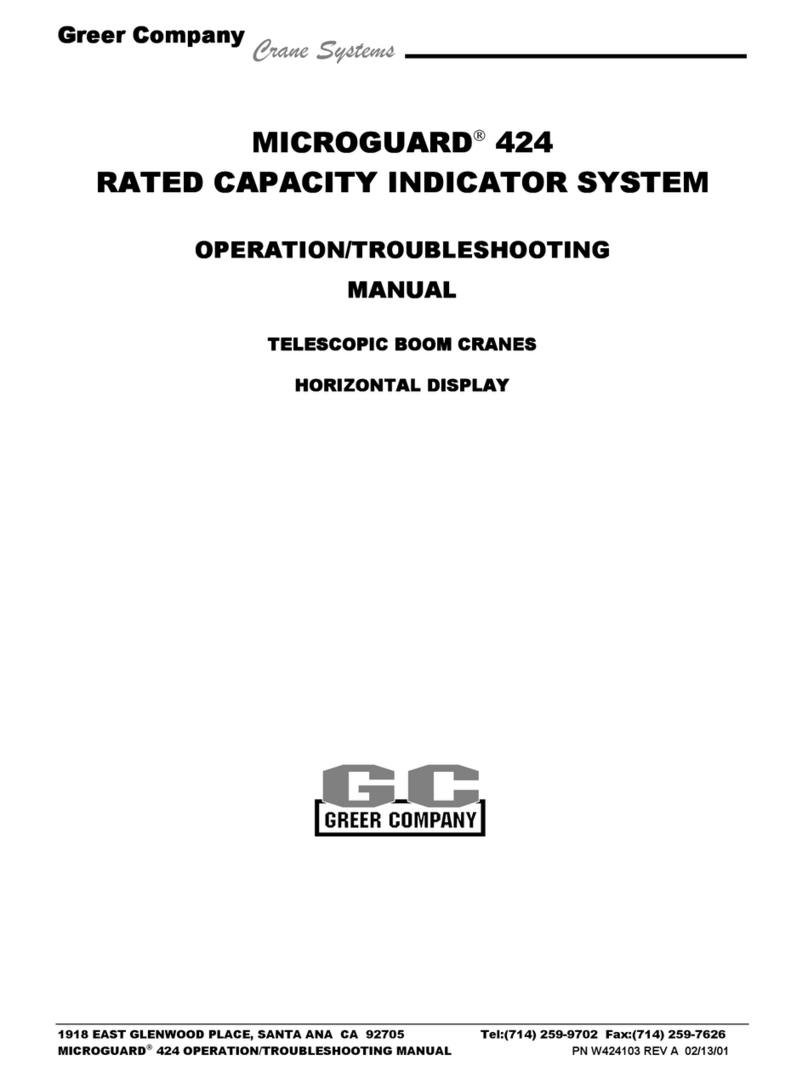
GREER Company
GREER Company MICROGUARD 424 User manual

GREER Company
GREER Company MG-534 Use and care manual
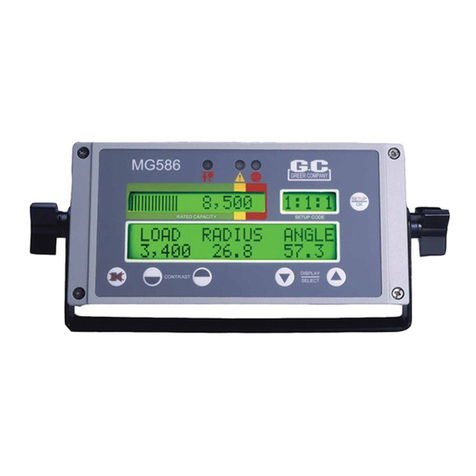
GREER Company
GREER Company MicroGuard 586 User manual
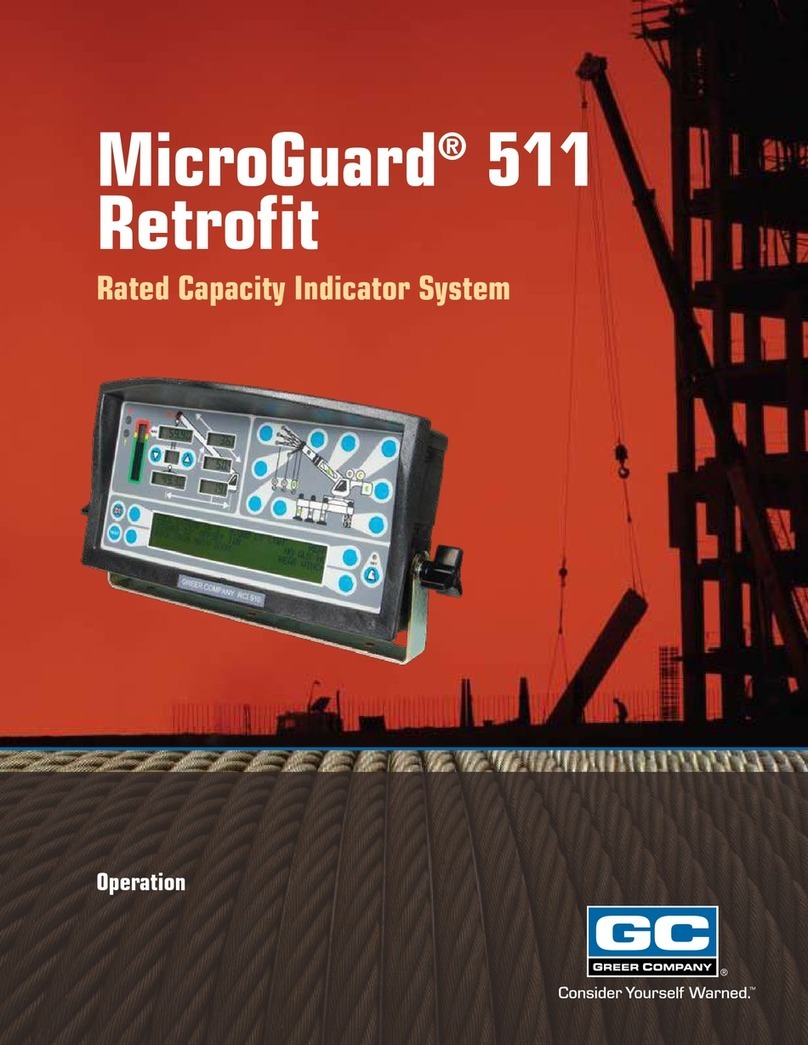
GREER Company
GREER Company MicroGuard 511 Retrofit Instruction Manual
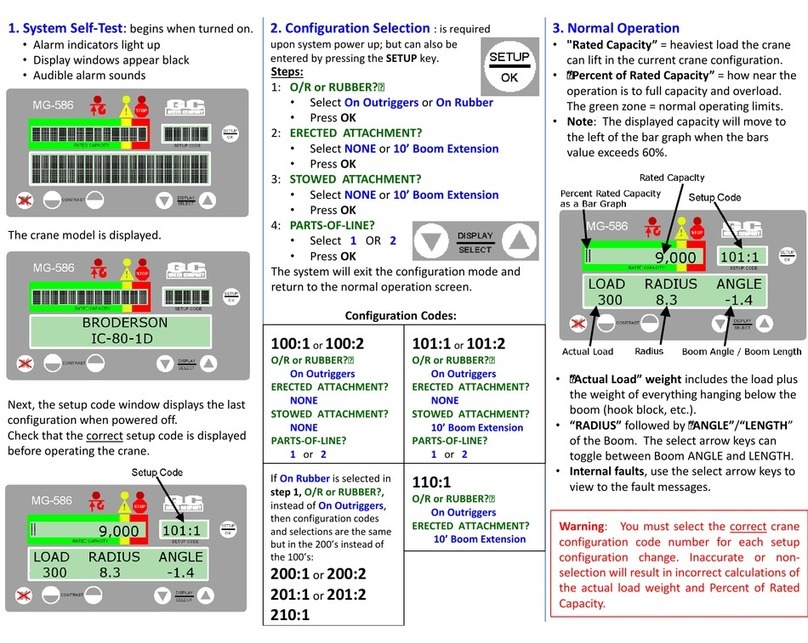
GREER Company
GREER Company MicroGuard 586 User manual

GREER Company
GREER Company MicroGuard 586 User manual

GREER Company
GREER Company MICROGUARD 424 User manual
